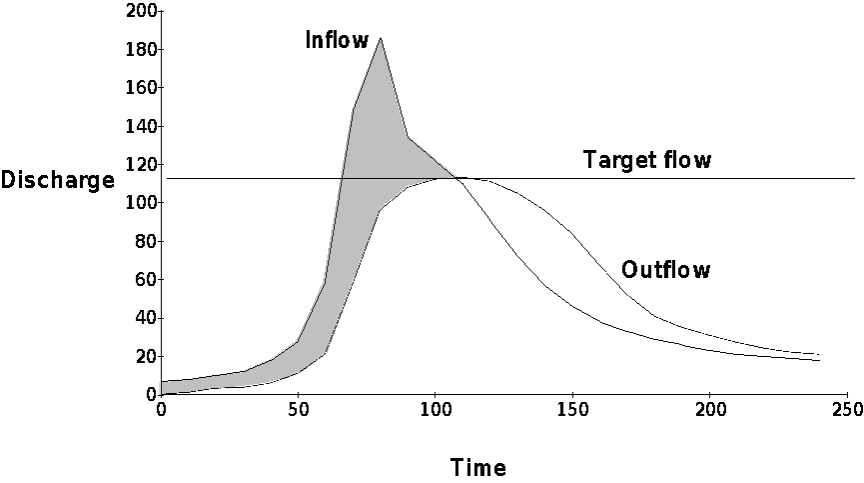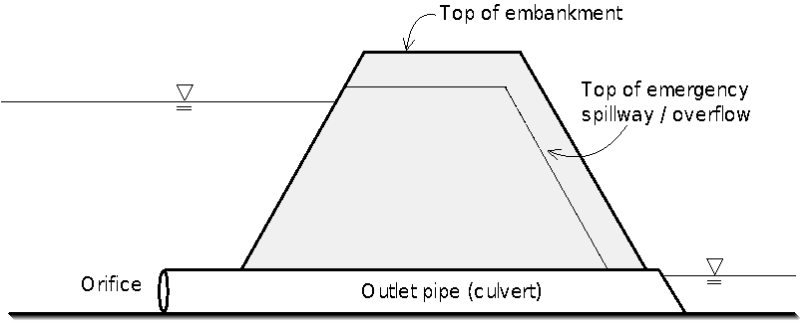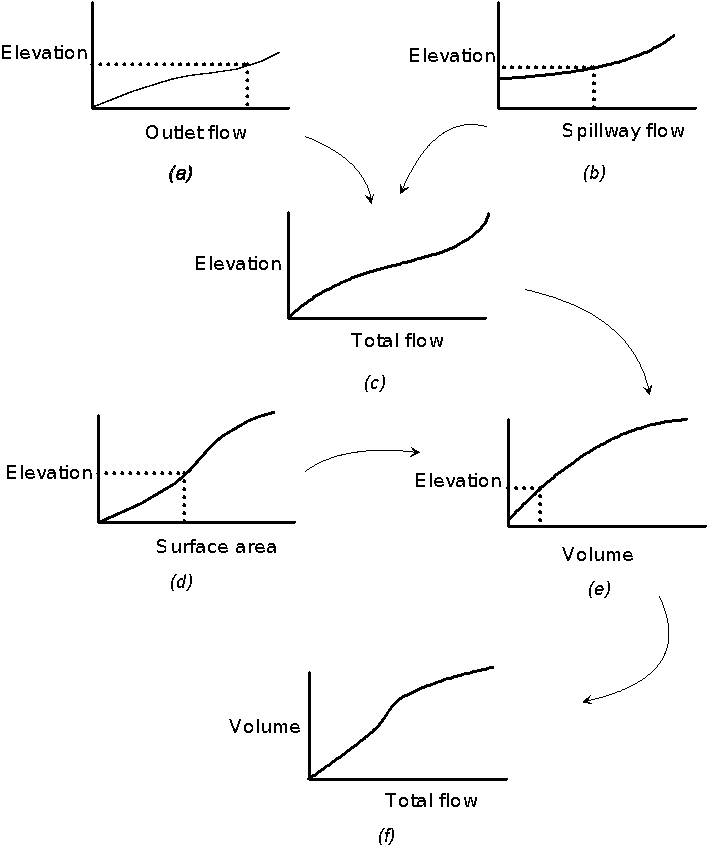Download PDF
Download page Reservoir and Detention Modeling.
Reservoir and Detention Modeling
A reservoir or detention pond mitigates adverse impacts of excess water by holding that water and releasing it at a rate that will not cause damage downstream. This is illustrated by the hydrographs shown in the Figure below. In this figure, the target flow (release from detention pond) is 113 units. The inflow peak is as shown in the figure; 186 units. To reduce this peak to the target level, storage is provided. Thus the volume of water represented by the shaded area is stored and then released gradually. The total volume of the inflow hydrograph and the volume of the outflow hydrograph (the dotted line) are the same, but the time distribution of the runoff is altered by the storage facility.
The next Figure below is a sketch of a simple detention structure. The structure stores water temporarily and releases it, either through the outlet pipe or over the emergency spillway. The configuration of the outlet works and the embankment in this illustration serves two purposes. It limits the release of water during a flood event, thus protecting downstream property from high flow rates and stages, and it provides a method of emptying the pond after the event so that the pond can store future runoff. (Also, check that this change in timing of the peak does not adversely coincide with flows from other parts of the basin.)
The reservoir outlet may consist of a single culvert, as shown in the Figure below. It may also consist of separate conduits of various sizes or several inlets to a chamber or manifold that leads to a single outlet pipe or conduit. The rate of release from the reservoir through the outlet and over the spillway depends on the characteristics of the outlet (in this case, a culvert), the geometric characteristics of the inlet, and the characteristics of the spillway.
Basic Concepts and Equations
Outflow from an impoundment that has a horizontal water surface can be computed with the so-called level-pool routing model (also known as Modified Puls routing model). That model discretizes time, breaking the total analysis time into equal intervals of duration \Delta t. It then solves recursively the following one-dimensional approximation of the continuity equation:
| 1) | I_{avg}-O_{avg}=\frac{\Delta S}{\Delta t} |
in which I_{avg} = average inflow during time interval; O_{avg} = average outflow during time interval; \Delta S = storage change. With a finite difference approximation, this can be written as:
| 2) | \frac{I_t+I_{t+1}}{2}-\frac{O_t+O_{t+1}}{2}=\frac{S_{t+1}-S_t}{\Delta t} |
in which t = index of time interval; I_t and I_{t+1} = the inflow values at the beginning and end of the t^{th} time interval, respectively; O_t and O_{t+1} = the corresponding outflow values; and S_t and S_{t+1} = corresponding storage values. This equation can be rearranged as follows:
| 3) | (\frac{2S_{t+1}}{\Delta t}+O_{t+1})=(I_t+I_{t+1})+(\frac{2S_t}{\Delta t}-O_t) |
All terms on the right-hand side are known. The values of I_t and I_{t+1} are the inflow hydrograph ordinates, perhaps computed with models described earlier in the manual. The values of O_t and S_t are known at the t^{th} time interval. At t = 0, these are the initial conditions, and at each subsequent interval, they are known from calculation in the previous interval. Thus, the quantity (\frac{2S_{t+1}}{\Delta t}+O_{t+1}) can be calculated with the above Equation. For an impoundment, storage and outflow are related, and with this storage-outflow relationship, the corresponding values of O_{t+1} and S_{t+1} can be found. The computations can be repeated for successive intervals, yielding values O_{t+1} , O_{t+2}, ... O_{t+n} , the required outflow hydrograph ordinates.
Setting Up a Reservoir Model
To model detention with the program, the storage-outflow relationship for the existing or proposed reservoir must be specified. The storage-outflow relationship (or elevation-storage-outflow or elevation-area-outflow relationship) that is developed and provided will depend on the characteristics of the pond or reservoir, the outlet, and the spillway. The Figure below illustrates how the relationship in a simple case might be developed. HEC-RAS or other hydraulics software can develop storage-outflow relationships for complex structures.
In the Figure above, (a) is the pond outlet-rating function; this relates outflow to the water-surface elevation in the pond. The relationship is determined with appropriate weir, orifice, or pipe formulas, depending on the design of the outlet. In the case of the configuration of the simple dentation structure shown in a Figure above, the outflow is approximately equal to the inflow until the capacity of the culvert is exceeded. Then water is stored and the outflow depends on the head. When the outlet is fully submerged, the outflow can be computed with the orifice equations:
| 4) | O=KA\sqrt{2gH} |
in which O = flow rate; K = dimensional discharge coefficient that depends upon the configuration of the opening to the culvert; A = the cross-sectional area of the culvert, normal to the direction of flow; H = total energy head on outlet. This head is the difference in the downstream water-surface elevation and the upstream (pond) water-surface elevation.
In the Figure above, (b) is the spillway rating function. In the simplest case, this function can be developed with the weir equation. For more complex spillways, refer to EM 1110-2-1603 (1990), to publications of the Soil Conservation Service (1985), and to publications of the Bureau of Reclamation (1987) for appropriate rating procedures.
In the Figure above, (a) and (b) are combined to yield (c), which represents the total outflow when the reservoir reaches a selected elevation.
In the Figure above, (d) is relationship of reservoir surface area to water-surface elevation; the datum for the elevation here is arbitrary, but consistent throughout the figure. This relationship can be derived from topographic maps or grading plans. In the Figure above, (e) is developed from this with solid-geometry principles.
For an arbitrarily-selected elevation, the storage volume can be found in (e), the total flow found in (c), and the two plotted to yield the desired relationship, as shown in (f). With this relationship, the weir equation can be solved recursively to find the outflow hydrograph ordinates, given the inflow.
Applicability and Limitations of the Detention Model
The reservoir model that is included in the program is appropriate for simulating performance of any configuration of outlets and pond. However, the model assumes that outflow is inlet-controlled. That is, the outflow is a function of the upstream water-surface elevation. If the configuration of the reservoir and outlet works is such that the outflow is controlled by a backwater effect (perhaps due to a downstream confluence), then the reservoir model should not be used. Instead, an unsteady-flow network model, such as HEC-RAS must be used to properly represent the complex relationship of storage, pond outflow, and downstream conditions. Further, if the reservoir is gated, and the gate operation is not uniquely a function of storage, then a reservoir system simulation model, such as HEC-ResSim, should be used.